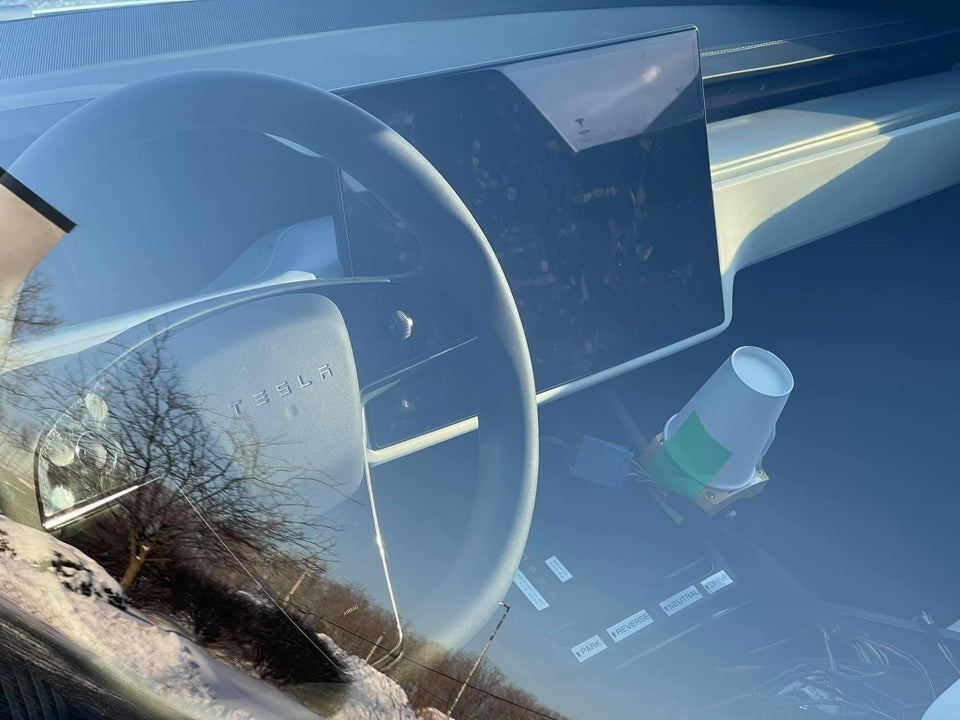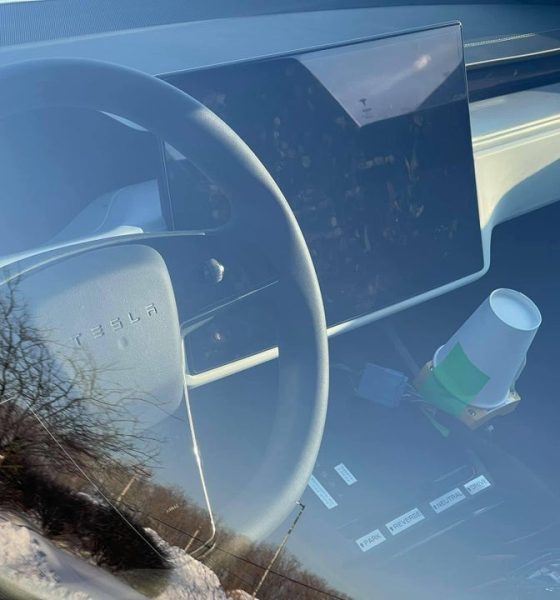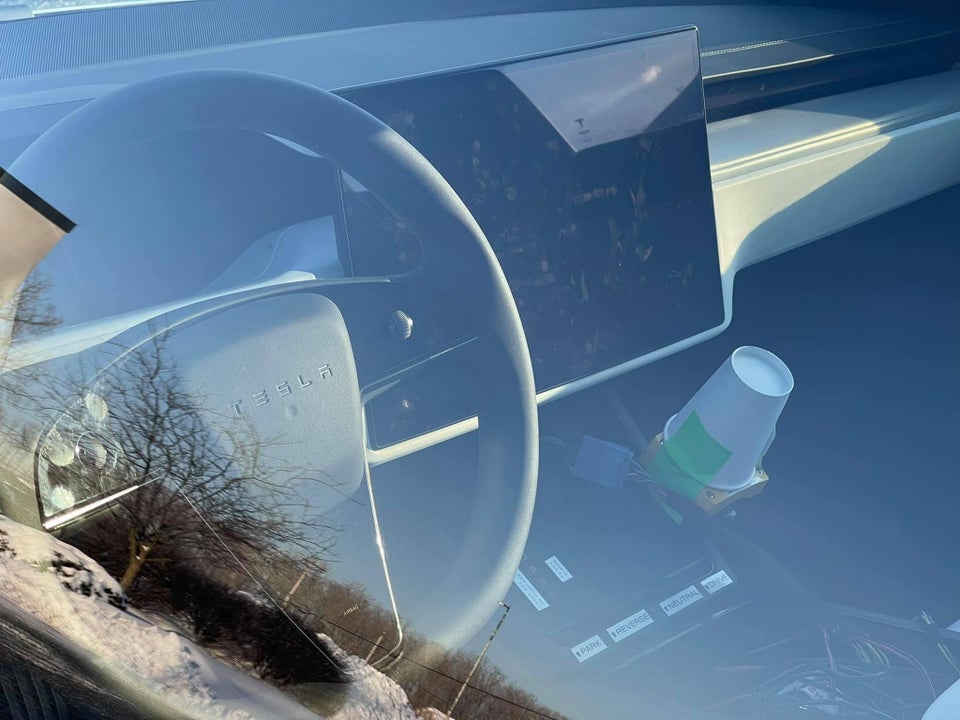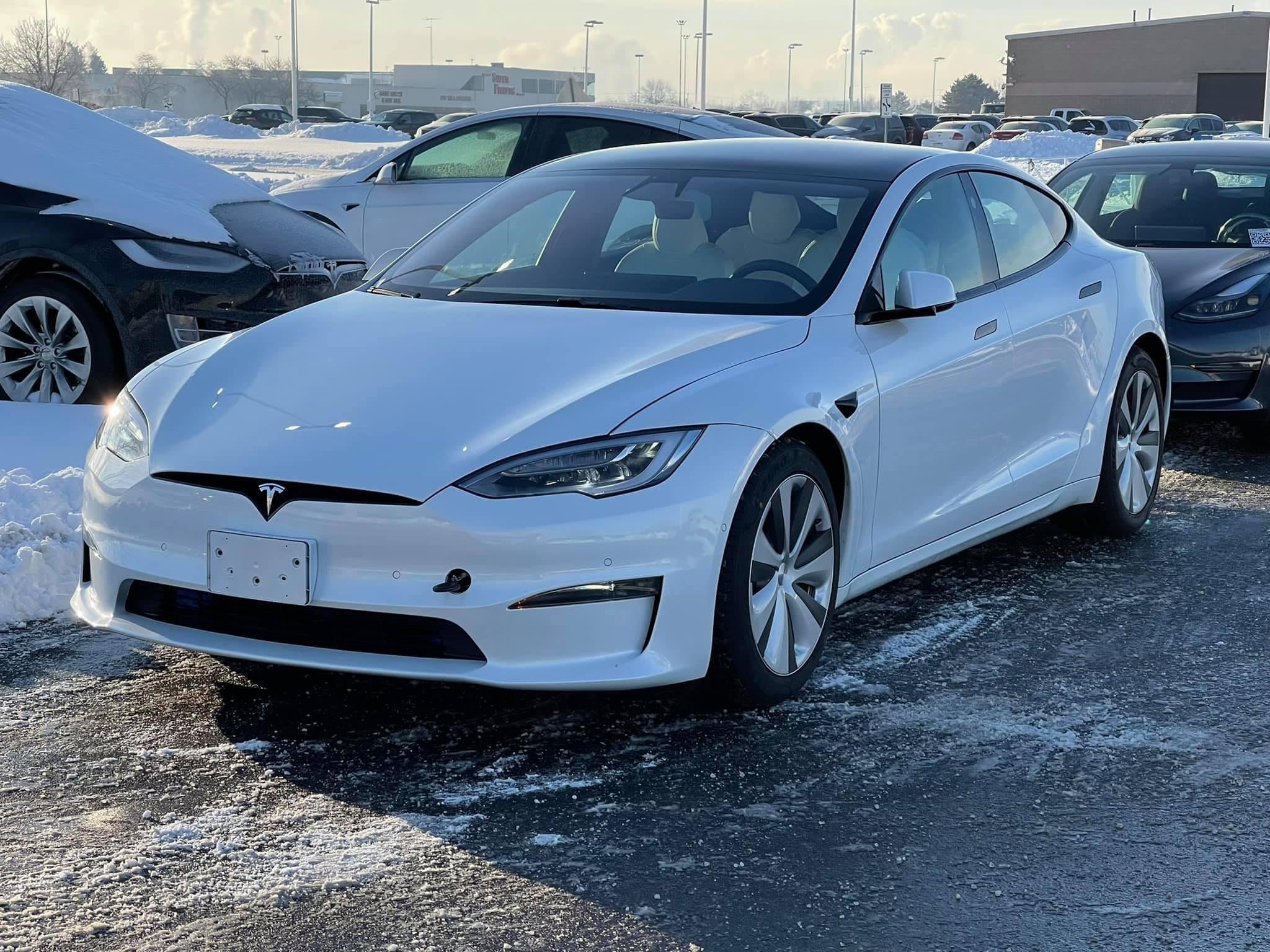

News
Tesla Model S ‘Refresh’ test vehicle interior: New Steering Wheel, Touchscreen, HVAC system
The first images of the Tesla Model S “Refresh” have landed online, after a person in Toledo, Ohio, spotted the newly-designed sedan at the Toledo Service Center. After speaking with Service Center employees, it has been confirmed that this is a test vehicle. However, images show that the Model S interior is here, and preliminary designs are in the works.
Upon the release of the Q4 2020 Earnings Call Update Letter, Tesla released new photographs of the Model S interior. Rumors that Tesla’s flagship sedan was going to be subjected to a “refresh” were spinning through the rumor mill since December 2020, after the company shut down production lines of the Model S and Model X at the Fremont factory. The vehicle was then spotted at the Fremont Test Track by Teslarati and the Kilowatts, further confirming that Tesla was revamping its flagship vehicle.
While exterior photos showed some changes, many were interested in whether Tesla would modify the interior design. It did, after confirming some new features in photographs that were included in the Q4 2020 Shareholder Deck. A new Yoke Steering wheel, horizontal touchscreen, and rear passenger screen were all included, along with modifications to the vehicle’s HVAC design, center console, and others.
Now, new images have surfaced of the Model S interior, thanks to Tom of the Tesla Owners Club of Michigan Facebook group. These photographs were then shared to the r/TeslaMotors Subreddit.

Credit: Tesla Owners Club of Michigan | Facebook
It appears that Tesla’s Yoke Steering Wheel will be optional and can be equipped with a new steering column design. The new steering wheel is noticeably different than past Model S steering wheels. The center of the wheel seems to have a cap for the horn instead of the past one-piece design that has been used.
As far as the Yoke design, the NHTSA has told Teslarati on several occasions that it will work with the automaker on the regulations regarding steering wheel shape. The Yoke has been approved in several other countries, but the NHTSA still hasn’t confirmed whether it will be allowed or not.
The NHTSA told Teslarati:
“At this time, NHTSA cannot determine if the steering wheel meets Federal Motor Vehicle Safety Standards. We will be reaching out to the automaker for more information.”
It also appears that this vehicle is undergoing some kind of testing as there are plenty of exposed wires and labels on the interior. Tesla has been known to test upcoming vehicles in a number of different conditions, including snow. Several past vehicle prototypes have run spirited drives in challenging, snowy conditions ahead of their releases. The Model Y and Semi are just two of them.
Tom, the original poster in the Facebook Group, stated that:
“Model S refresh test vehicle spotted at the Toledo service center!! Sorry for the crummy photos. Best I could do at the time. Also, yoke steering wheel confirmed as option, by service staff!!”
Credit: Tesla Owners Club of Michigan | Facebook
Tesla is currently producing the refreshed Model S and Model X at the Fremont Factory, and has contacted orderers about their possible delivery dates. One Model X reservation holder told Teslarati earlier this month that his planned delivery date is between February 15th and March 15th, meaning that the new vehicles could be rolling into customer driveways any day now.
Tesla’s Crash Testing History in Ohio
While unclear for the exact reasoning that Tesla sent a Model S Refresh to Ohio, there is some history with Tesla’s soon-to-be-released cars in the state. In 2017 before the Model 3 was officially released and began deliveries, Tesla sent almost 100 Model 3s to Central Ohio for crash testing.
According to @Model3Owners, Tesla was sending the Model 3s to an independent crash safety testing facility, run by the Transportation Research Center‘s “Smart Mobility Advanced Research Test Center,” a $45 million facility that sits on 540 acres. Ohio State University and the Ohio Department of Transportation both donated at least $20 million to the facility that tests a wide variety of crash scenarios for automakers.
With the Model S having a new design, it is possible that Tesla could be sending the new car, along with several others, to the Transportation Research Center facility to test its performance in accidents. While the Model S already holds a five-star crash safety rating from the NHTSA, the slightly refined body design could need some additional research from Tesla to keep its great reputation for making safe vehicles.

News
Tesla FSD fleet is nearing 7 billion total miles, including 2.5 billion city miles
As can be seen on Tesla’s official FSD webpage, vehicles equipped with the system have now navigated over 6.99 billion miles.

Tesla’s Full Self-Driving (Supervised) fleet is closing in on almost 7 billion total miles driven, as per data posted by the company on its official FSD webpage.
These figures hint at the massive scale of data fueling Tesla’s rapid FSD improvements, which have been quite notable as of late.
FSD mileage milestones
As can be seen on Tesla’s official FSD webpage, vehicles equipped with the system have now navigated over 6.99 billion miles. Tesla owner and avid FSD tester Whole Mars Catalog also shared a screenshot indicating that from the nearly 7 billion miles traveled by the FSD fleet, more than 2.5 billion miles were driven inside cities.
City miles are particularly valuable for complex urban scenarios like unprotected turns, pedestrian interactions, and traffic lights. This is also the difference-maker for FSD, as only complex solutions, such as Waymo’s self-driving taxis, operate similarly on inner-city streets. And even then, incidents such as the San Francisco blackouts have proven challenging for sensor-rich vehicles like Waymos.
Tesla’s data edge
Tesla has a number of advantages in the autonomous vehicle sector, one of which is the size of its fleet and the number of vehicles training FSD on real-world roads. Tesla’s nearly 7 billion FSD miles then allow the company to roll out updates that make its vehicles behave like they are being driven by experienced drivers, even if they are operating on their own.
So notable are Tesla’s improvements to FSD that NVIDIA Director of Robotics Jim Fan, after experiencing FSD v14, noted that the system is the first AI that passes what he described as a “Physical Turing Test.”
“Despite knowing exactly how robot learning works, I still find it magical watching the steering wheel turn by itself. First it feels surreal, next it becomes routine. Then, like the smartphone, taking it away actively hurts. This is how humanity gets rewired and glued to god-like technologies,” Fan wrote in a post on X.
News
Tesla starts showing how FSD will change lives in Europe
Local officials tested the system on narrow country roads and were impressed by FSD’s smooth, human-like driving, with some calling the service a game-changer for everyday life in areas that are far from urban centers.

Tesla has launched Europe’s first public shuttle service using Full Self-Driving (Supervised) in the rural Eifelkreis Bitburg-Prüm region of Germany, demonstrating how the technology can restore independence and mobility for people who struggle with limited transport options.
Local officials tested the system on narrow country roads and were impressed by FSD’s smooth, human-like driving, with some calling the service a game-changer for everyday life in areas that are far from urban centers.
Officials see real impact on rural residents
Arzfeld Mayor Johannes Kuhl and District Administrator Andreas Kruppert personally tested the Tesla shuttle service. This allowed them to see just how well FSD navigated winding lanes and rural roads confidently. Kruppert said, “Autonomous driving sounds like science fiction to many, but we simply see here that it works totally well in rural regions too.” Kuhl, for his part, also noted that FSD “feels like a very experienced driver.”
The pilot complements the area’s “Citizen Bus” program, which provides on-demand rides for elderly residents who can no longer drive themselves. Tesla Europe shared a video of a demonstration of the service, highlighting how FSD gives people their freedom back, even in places where public transport is not as prevalent.
What the Ministry for Economic Affairs and Transport says
Rhineland-Palatinate’s Minister Daniela Schmitt supported the project, praising the collaboration that made this “first of its kind in Europe” possible. As per the ministry, the rural rollout for the service shows FSD’s potential beyond major cities, and it delivers tangible benefits like grocery runs, doctor visits, and social connections for isolated residents.
“Reliable and flexible mobility is especially vital in rural areas. With the launch of a shuttle service using self-driving vehicles (FSD supervised) by Tesla in the Eifelkreis Bitburg-Prüm, an innovative pilot project is now getting underway that complements local community bus services. It is the first project of its kind in Europe.
“The result is a real gain for rural mobility: greater accessibility, more flexibility and tangible benefits for everyday life. A strong signal for innovation, cooperation and future-oriented mobility beyond urban centers,” the ministry wrote in a LinkedIn post.
News
Tesla China quietly posts Robotaxi-related job listing
Tesla China is currently seeking a Low Voltage Electrical Engineer to work on circuit board design for the company’s autonomous vehicles.

Tesla has posted a new job listing in Shanghai explicitly tied to its Robotaxi program, fueling speculation that the company is preparing to launch its dedicated autonomous ride-hailing service in China.
As noted in the listing, Tesla China is currently seeking a Low Voltage Electrical Engineer to work on circuit board design for the company’s autonomous vehicles.
Robotaxi-specific role
The listing, which was shared on social media platform X by industry watcher @tslaming, suggested that Tesla China is looking to fill the role urgently. The job listing itself specifically mentions that the person hired for the role will be working on the Low Voltage Hardware team, which would design the circuit boards that would serve as the nervous system of the Robotaxi.
Key tasks for the role, as indicated in the job listing, include collaboration with PCB layout, firmware, mechanical, program management, and validation teams, among other responsibilities. The role is based in Shanghai.
China Robotaxi launch
China represents a massive potential market for robotaxis, with its dense urban centers and supportive policies in select cities. Tesla has limited permission to roll out FSD in the country, though despite this, its vehicles have been hailed as among the best in the market when it comes to autonomous features. So far, at least, it appears that China supports Tesla’s FSD and Robotaxi rollout.
This was hinted at in November, when Tesla brought the Cybercab to the 8th China International Import Expo (CIIE) in Shanghai, marking the first time that the autonomous two-seater was brought to the Asia-Pacific region. The vehicle, despite not having a release date in China, received a significant amount of interest among the event’s attendees.








